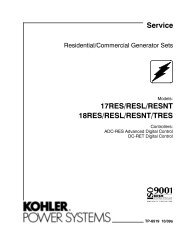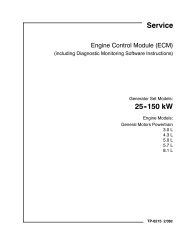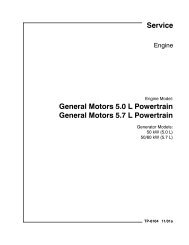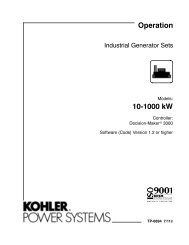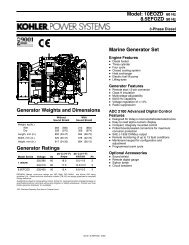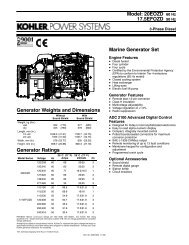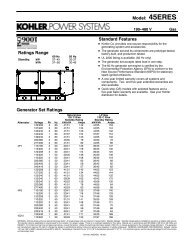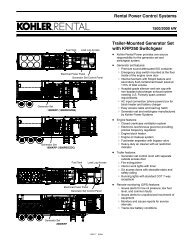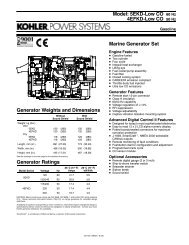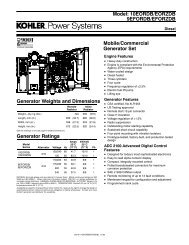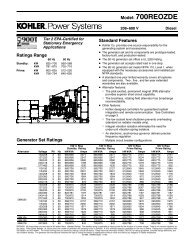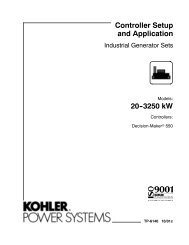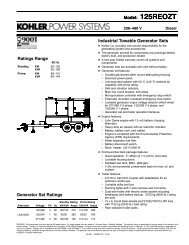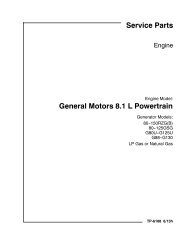Service Manual, General Motors 4.3L Engine (TP ... - Kohler Power
Service Manual, General Motors 4.3L Engine (TP ... - Kohler Power
Service Manual, General Motors 4.3L Engine (TP ... - Kohler Power
Create successful ePaper yourself
Turn your PDF publications into a flip-book with our unique Google optimized e-Paper software.
<strong>Engine</strong> Marine/Industrial <strong>4.3L</strong> 6-15<br />
Excessive oil consumption (not due to leaks) is the use<br />
1.9 liters (2 quarts) of engine oil within 3,200 kilometers<br />
(2,000 miles). However, during initial engine break-in<br />
periods 4,828-6,437 kilometers (3,000-4,000 miles) oil<br />
consumption may exceed 1.9 liters (2 quarts) or more.<br />
The causes of excessive oil consumption include the<br />
following conditions:<br />
• External oil leaks. Tighten the bolts and/or<br />
replace gaskets and oil seals as necessary.<br />
• Incorrect oil level or improper reading of oil<br />
level indicator. With the vehicle on a level<br />
surface, allow adequate drain down time and<br />
check for the correct oil level.<br />
• Improper oil viscosity. Use a recommended<br />
SAE viscosity for the prevailing temperatures.<br />
• Continuous high speed operation and/or<br />
severe usage.<br />
• Crankcase ventilation system restrictions or<br />
malfunctioning components. Possible improper<br />
PCV valve.<br />
• Valve guides and/or valve stem oil seals worn,<br />
damaged or the seal omitted. Ream the valve<br />
guides and install oversize service valves and/<br />
or new valve stem oil seals.<br />
• Piston rings broken, improperly installed, worn<br />
or not seated properly. Allow adequate time for<br />
the piston rings to seat. Replace broken or<br />
worn piston rings as necessary.<br />
• Piston improperly installed or mis-fitted.<br />
Oil Pressure Diagnosis and Testing<br />
1. With the vehicle on a level surface, allow<br />
adaquate drain down time (2-3 minutes) and<br />
measure for a low engine oil level.<br />
Add the recommended grade engine oil, and fill<br />
the crankcase until the oil level measures FULL<br />
on the oil level indicator.<br />
2. Operate the engine and verify low or no oil<br />
pressure on the vehicle oil pressure gauge or the<br />
oil indicator light.<br />
Listen for a noisy valve train or a knocking noise.<br />
3. Inspect for the following:<br />
• <strong>Engine</strong> oil diluted by moisture or unburned fuel<br />
mixtures<br />
• Improper engine oil viscosity for the expected<br />
temperature<br />
• Incorrect or faulty oil pressure gauge sensor<br />
• Incorrect or faulty oil pressure gauge<br />
• Plugged oil filter<br />
• Malfunctioning oil filter bypass valve<br />
4. Remove the oil pressure gauge sensor or<br />
another engine block oil gallery plug.<br />
5. Install an oil pressue gauge.<br />
6. Start the engine and then allow the engine to<br />
reach normal operation temperature.<br />
7. Measure the engine oil pressure at the following<br />
RPM:<br />
Specification<br />
7.1. 42 kPa (6psig) (minimum) at 1,000 RPM<br />
7.2. 125 kPa (18 psig) (minimum) at 2,000 RPM<br />
7.3. 166 kPa (24 psig) (minimum) at 4,000 RPM<br />
8. If the engine oil pressure is below minimum<br />
specifications, inspect the engine for one or<br />
more of the following:<br />
• Oil pump worn or dirty<br />
• Malfunctioning oil pump pressure relief valve<br />
• Oil pump screen loose, plugged or damaged<br />
• Excessive bearing clearance<br />
• Cracked, porous or restricted oil galleries<br />
• <strong>Engine</strong> block oil gallery plugs missing or<br />
incorrectly installed<br />
• Broken valve lifters<br />
2000 Marine/Industrial



